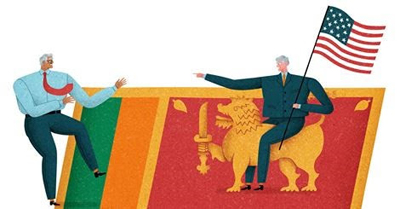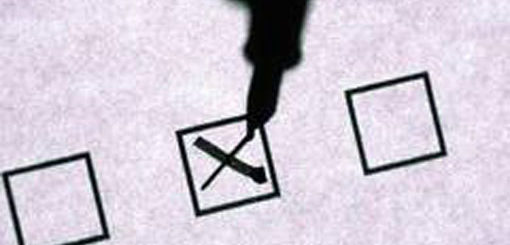Main elements of New Constitution drafted by British Solicitors in 1994
“A Framework for the Constitution of the Union of Ceylon” prepared in 1994 by a firm of British solicitors (Bates, Wells and Braithwaite) for the Sri Lanka Peace Support Group an entity within the Centre of Policy Alternatives.

Constitution. Illustration: Ratna Sagar Shrestha.THT
What is interesting about this proposal is that it lays out the nuts and bolts of a confederate structure; a concept that many are unfamiliar with but elements which are being peddled through the present constitution giving rise to the reality that this new constitution is certainly not drafted in Sri Lanka by the people whom the government claims to have appointed and none of the proposals that were requested by the public have been taken into consideration. A careful reading of the 1994 proposal compared with the clauses being presently promoted and the slogans used will clearly reveal that these documents have been kept ready until their ‘men’ have been brought into power by regime change. For these reasons and more the citizens of Sri Lanka must reject this new constitution.
The letter sent by the British solicitors to both President Kumaratunga & Prabakaran is enclosed
http://www.sangam.org/FB_HIST_DOCS/UKLetters.htm
Cover letter http://www.sangam.org/FB_HIST_DOCS/UKMessage.htm
The full text of the proposal
http://www.sangam.org/FB_HIST_DOCS/UKProposal.htm
The proposal by the British firm was on the request of an entity known as Sri Lanka Peace Support Group formed within the Centre for Policy Alternatives. Guess who members of this group consisted
- Radhika Coomaraswamy
- Sunila Abeysekera
- Sunil Bastian
- Sunanda Deshapriya
- Rohan Edrisinha
- Kethesh Loganathan
- Jehan Perera
- Paikiasothy Saravanamuttu
- Jeevan Thiagarajah
- Joe William
- Javed Yusuf
http://www.uthr.org/Peace/PSG_on%20_peace_talks.htm
Their statements from 2000 to 2006 are available on the CPA website – http://www.cpalanka.org/peace-support-group-psg-statements-2000-to-2006/
The Group issued an open letter for the 2001 elections http://www.island.lk/2001/11/04/featur09.html and the proposals they make clearly indicate where their allegiance lies.
In 2002 Daily News featured an article by Centre of Policy Alternatives Director Rohan Edrisinha titled Meeting Tamil aspirations within a united Lanka”. http://archives.dailynews.lk/2002/06/24/fea01.html
Salient points covered in his article is important to understanding who is peddling the new constitution and what the real gameplan is.
Edirsinha makes reference to the banned LTTE front leader of Transnational Government of Tamil Eelam, Rudrakumaran who was also the lawyer for LTTE referring to the need for Tamil self-determination as part of a political solution. Edirisinha agrees to that right.
Interesting is the quote maximum devolution within a united country seemed to be the philosophy behind a proposal submitted to President Kumaratunga and Prabakaran” on 20 December 1995 prepared by a British law firm Bates, Wells & Braithwaite on request of Sri Lanka Peace Support Group.
Don’t know where era Edirisinha was living in as he claims the ‘proposal basically provided for a confederation the Union of Ceylon consisting of two internally autonomous states, one for the Tamil area (north east of the country) and the other for the mainly Sinhalese areas’.
The other areas that the proposal covered were
Apart from foreign affairs, external defence and security monetary policy and currency, maintenance of relations between the states and a few other matters, each state would have the power to adopt its own constitution which would have to endorse certain core principles set out in the Preamble to the Constitution and entrenched clauses on human rights, while setting out its own structure of government, have its own Prime Minister and exercise complete autonomy in all other areas.”
It provided for a Central Council of the Union to exercise power with respect to the reserved subjects and to provide a channel of communication and co-ordination between the two states consisting of an equal number of representatives from the states. The Council would appoint a President and Deputy President of the Union from amongst its members for a specified time with agreed alternation between representatives of each state.”
The citizens of the union would share a common nationality and have the freedom of movement and the right to reside and work in any part of the union.”
The proposal provided for a Constitutional Court consisting of an equal number of judges from each state and a suggestion that one or more non-Ceylonese judges of international repute be included as well. The main function of the Court would be to interpret the Constitution and to ensure state compliance with the provisions of the preamble and the human rights provisions of the Constitution.”
Under a provision titled ‘Referendum & Guarantees’ the proposal provides each state to conduct a referendum to ‘modify the powers of the Union affecting that State’. Is this not another means for UDI?
What is bizarre is that it also included provision in implementing the Constitution and maintenance of peace between the 2 States guaranteed by the United Nations!
This law firm was suggesting to create two independent & sovereign entities confirmed in the Preamble that relations between the 2 States would be governed according to the ‘applicable principles of international law & justice’.
It is shocking that a British law firm would continue to refer to Sri Lanka as ‘Ceylon’ and questions which era they are living in. However, the elements proposed clearly tally with the present elements of the new constitution putting those who come before us as being the persons drafting the constitution to ridicule!
Shenali D Waduge





